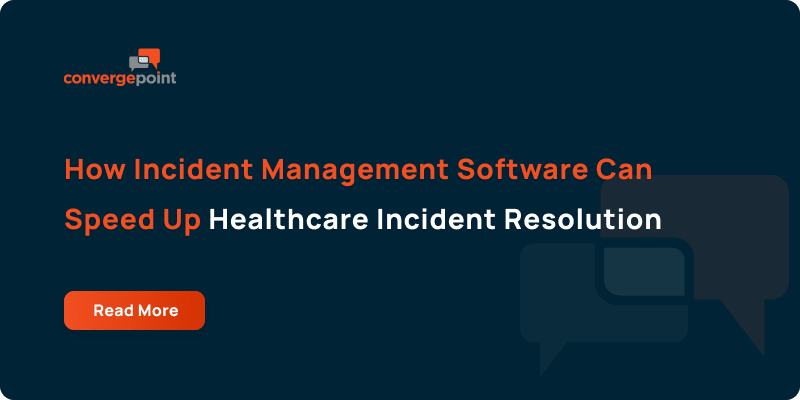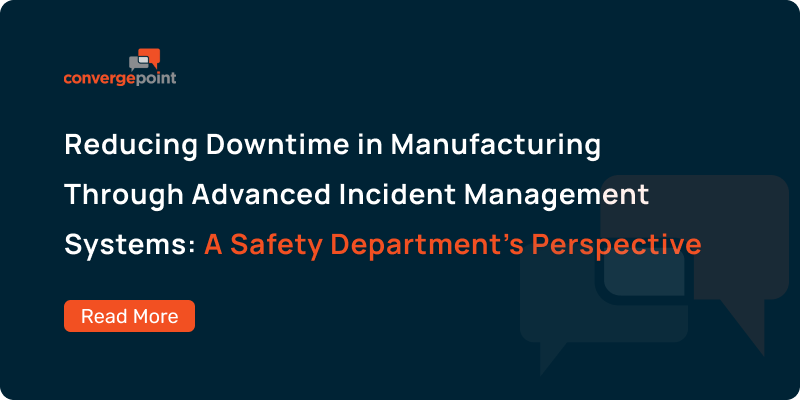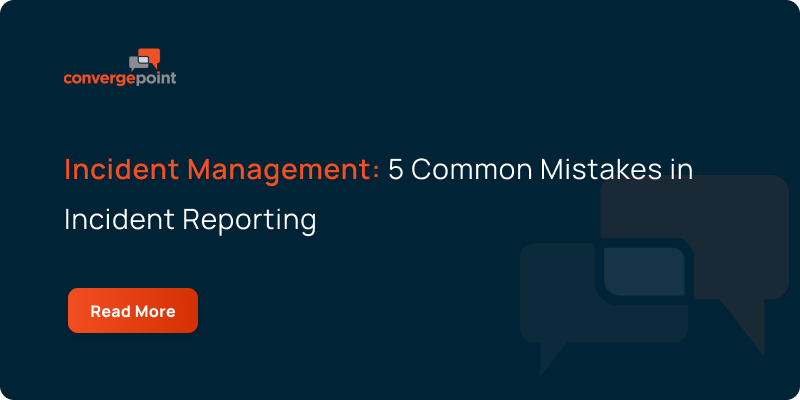Incident Management
Resources, best practices, articles, guides, and how-tos to effectively manage incidents.
How healthcare providers can resolve incidents faster and reduce compliance risks with ConvergePoint Incident Management Software built on Microsoft 365 SharePoint.
A structured incident response lifecycle helps organizations contain disruptions, investigate root causes, and implement corrective actions to minimize risks and maintain operational stability.
Minimize downtime and enhance safety in manufacturing with advanced incident management. Learn how structured reporting and real-time collaboration keep operations running smoothly.
Explore how a healthcare provider overcame manual incident reporting challenges using ConvergePoint Incident Management Software on SharePoint, improving efficiency, compliance, and response times.
Gain insights into managing, investigating, and resolving workplace incidents with intelligent incident forms, automated tracking, and streamlined workflows on Microsoft 365 SharePoint for better efficiency.
Workplace investigations can be complex and time-consuming. Discover 4 best practices to manage cases efficiently, ensure fairness, and achieve thorough resolutions without unnecessary delays.
Incident reporting can be tedious, but common mistakes make it even harder. Discover 5 frequent errors to avoid and learn how to improve accuracy, efficiency, and compliance in your incident management process.
Explore expert tips for selecting the right employee training software that enhances engagement, simplifies onboarding, supports compliance, and ensures a seamless training experience for your team.
Learn the 7 essential steps for conducting a thorough workplace investigation. From handling complaints to navigating regulatory changes, ensure your organization responds effectively and accurately.
Review key steps in assessing the effectiveness of corrective actions and the investigation process. Learn how to prevent future incidents with a thorough checklist for ongoing improvement and compliance.
Explore why 'accidents' shouldn't be part of incident reporting. Understand how focusing on root causes and preventive measures leads to more accurate data and improved safety practices in the workplace.
Understand why incidents should be viewed as system non-conformances within broader EHS management. Learn how integrating incident management ensures better safety and reduces risks across your organization.
Discover how HR case management software boosts efficiency, organizes workflows, and improves team collaboration. Build a strong case for adopting a solution that transforms HR operations and reduces complexity.
Explore the key components of a safety management system. Discover how to create a comprehensive checklist that supports safety protocols, compliance, and effective risk management across your organization.
Learn how competence in safety management plays a critical role in compliance. Discover the knowledge, skills, and abilities that define competence and its importance in ensuring safety across tasks and jobs.
Discover best practices for improving your safety management and incident management software. Access useful guides and tips to optimize your system and ensure a safer, more compliant workplace.
Understand why safety procedures are not isolated. Explore how they connect to overall safety management, ensuring consistency in handling risks and improving workplace safety across various operations.
Discover how to make workplace safety training more engaging and effective. Learn strategies to keep employees interested while boosting productivity and ensuring a safer, more efficient workplace.
Learn the key differences between hazards and risks in safety management. Explore how clear safety procedures and effective training help identify and address potential dangers in the workplace.
Explore the essentials of industrial hygiene risk. Learn how identifying and controlling workplace factors that affect health is crucial for protecting employees and the surrounding community.
Discover the true role of PPE in safety management. Learn why it’s crucial in preventing injuries and illnesses, even if it's considered a last resort in controlling workplace hazards and risks.
Competence in safety is vital. See how safety training software equips employees with the skills, knowledge, and understanding needed to identify and address workplace hazards effectively.
Safety training is essential for every employee, not just those in high-risk roles. It equips everyone with the knowledge to reduce workplace hazards, prevent accidents, and promote a safer environment.
Stress impacts focus and safety performance. Understand how stress contributes to human error in the workplace and how safety training can help workers manage stress for safer, more effective operations.
Understand how Deming's PDCA cycle—Plan, Do, Check, Act—plays a key role in safety management. His system-focused approach drives continuous improvement and ensures more efficient safety practices.
Safety training proves its worth over time. While upfront costs are clear, the long-term benefits like reduced incidents, enhanced productivity, and a stronger safety culture outweigh the expenses.
Effective employee investigations require asking the right questions to uncover the truth. Use a flexible approach that adapts to the conversation, ensuring all relevant details are gathered during interviews.
Temporary work includes roles with a defined duration, such as contract, seasonal, or freelance positions. It's vital to extend the same safety training and protocols to temporary workers as permanent staff.
Transform your EHS training with custom quizzes, auto-reminders, and flexible access. Track certifications and support employees in achieving compliance and success.
Learn how to effectively include contract employees in your safety management system. Account for their unique needs, ensuring safety while they contribute to specific tasks or projects within your organization
Use this checklist to refine your incident and case management processes. Take clear, effective steps to resolve employee incidents, maintain compliance, and promote transparency and accountability in your organization.
Establish efficient case management processes with this guide. Streamline reporting, investigating, and resolution phases for HR and compliance managers to improve timeliness, reduce consequences, and optimize resources.
Strengthen your organization's safety culture by enhancing health and safety training. Focus on key areas for improvement to ensure employees prioritize safety and reduce the need for enforcement measures.
Accurate incident reporting is key to improving performance and safety outcomes. By tracking incidents and near misses, organizations can identify risks, reduce accidents, and enhance overall safety performance.
ConvergePoint incident and case management software on SharePoint streamlines incident reporting and tracking, ensuring a comprehensive system for addressing incidents, from minor to major, with efficiency and compliance.
Ensure thorough incident reporting with our checklist for your Incident Report Template. Accurately define terms, provide necessary details, include supporting evidence, and create a repeatable report structure.
Gain insights into improving safety with our white paper on Safety Management Software. Understand workplace incident statistics and explore how effective software solutions can help reduce workplace risks and fatalities.
Stay compliant with OSHA regulations by understanding the types of incidents that require immediate reporting. Learn which workplace injuries, such as fatalities or amputations, must be reported to OSHA.
Track and analyze incident report statistics to better understand workplace safety trends. Gaining insights into fatality data and workplace incidents can help your organization improve safety measures and compliance.
Centralize all safety-related documentation into one repository. Use ConvergePoint Health and Safety Management Software to store procedures, guidelines, and other crucial documents for easy access and better management.
Near misses are often under-reported despite being significant indicators of potential safety risks. Properly documenting and investigating near misses can help prevent future accidents and improve safety protocols.
While behavior-based safety emphasizes worker actions, it may overlook systemic factors in incident investigation. A broader systems approach, as recommended by OSHA, identifies root causes beyond human error.
OSHA's new rule mandates employers to electronically submit workplace injury and illness data, aiming for transparency and improved safety. This 'nudge' encourages employers to focus on safety and inform the public.
Is PPE unfairly blamed for workplace incidents? While considered the last line of defense in risk management, PPE is essential in preventing injuries and illnesses. Learn how it supports overall safety.
Improved incident reporting leads to better safety performance. Studies show that by increasing hazard and near-miss reporting, organizations can reduce incident rates significantly, ensuring a safer workplace.
Timely response to workplace incidents is crucial for business growth. Implementing case management software helps streamline investigations, prevent legal issues, and maintain employee morale and safety
Root Cause Analysis helps prevent recurring incidents. Our checklist covers assessing incidents, identifying causes, and logistics for conducting and implementing effective investigations in your organization.
Temporary workers should always be treated with the same priority for safety as permanent staff. Safety is never temporary—make sure safety procedures apply to all employees, regardless of contract type.
Near misses are often precursors to serious incidents. Proper investigation and corrective actions can prevent future accidents. Download our checklist to ensure a thorough approach to near miss management.
PPE is often seen as the last line of defense in safety management, but it plays a crucial role in protecting workers from serious injuries and illnesses. It includes face shields, hard hats, gloves, and more.
Policies and procedures are essential for a robust safety management system. They guide safety decisions and ensure tasks are performed correctly, preventing the risk of safety failures within the workplace.
Post-incident recall is vital for reinforcing lessons learned, communicating outcomes to employees, and improving safety management systems. Learn how your organization can close the loop effectively.
Training is crucial for improving performance, awareness, and safety. Equip employees with the right skills and knowledge to identify hazards, follow safety protocols, and foster a safer workplace culture.
Ensure your business meets OSHA requirements with a comprehensive safety training manual. This checklist helps you cover safe work practices, administrative tasks, and reporting requirements effectively.
Safety Training Software on SharePoint ensures your organization stays compliant by managing training records, certifications, licenses, and more. Simplify safety management for EHS, HR, and compliance teams.
Security management involves identifying and protecting organizational assets through strategic policies, procedures, and resources. It complements safety by focusing on collective protection and risk control.
ConvergePoint’s SharePoint Employee Health and Safety Training Management Software streamlines employee training, reporting, and EHS compliance, reducing risk, cost, and incidents while ensuring compliance.
Compliance is central to safety management, influencing everything from procedures and training to incident reporting. This article explores legal and system compliance, two crucial yet complex aspects.
Discover how EHS Training Software tackles workplace injuries, boosting morale, safeguarding company reputation, and ensuring compliance. Learn the top 10 reasons to implement this solution for better safety management.
Improve incident response times with case management software. Learn how it boosts reporting, tracking, investigation, and correction, helping EHS and HR professionals streamline processes and enhance efficiency.


























































